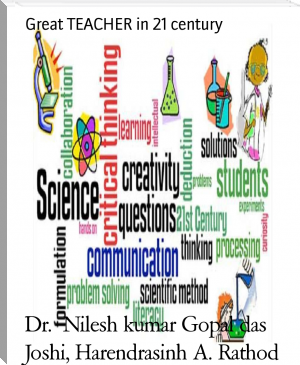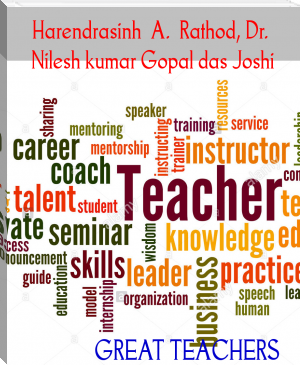Great TEACHER in 21 century, Dr. Nilesh kumar Gopal das Joshi, Harendrasinh A. Rathod [good english books to read txt] 📗

Book online «Great TEACHER in 21 century, Dr. Nilesh kumar Gopal das Joshi, Harendrasinh A. Rathod [good english books to read txt] 📗». Author Dr. Nilesh kumar Gopal das Joshi, Harendrasinh A. Rathod
.
Chapter 1 EDUCATION IN THE 21ST CENTURYEDUCATION IN THE 21ST CENTURY
THE VALUE OF A 21ST CENTURY EDUCATION
Success looks different now than it did in the past. High-achieving people are frequently choosing to opt out of the traditional job market and create their own jobs. Successful people increasingly expect to be able to:
Live and work anywhere in the world Travel as often as they like, for as long as they like Change what they’re working on to keep up with their interests and abilities Enjoy earning potential that is not capped by a salary figure Work with peers across the globe Outsource things they don’t like doing Choose their own hours and officeFor people who don’t live like this it can sound far-fetched, but this kind of lifestyle is growing rapidly. What does it take to access and thrive with this kind of freedom? The answer is surprisingly simple, and can be best summed up as ‘a 21st century education’.
20TH CENTURY EDUCATION
In the preface to the 2011 revised edition of his book ‘Out of Our Minds’, Sir Ken Robinson observes that ‘The more complex the world becomes, the more creative we need to be to meet its challenges’, and this is becoming increasingly clear in education and the workplace. People now need to be creative to be successful, but while the idea of success has changed, the education system has not always adjusted its methods or goals to meet it.
A 20th century education emphasised compliance and conformity over creativity, two skills that were necessary to do well in a professional or corporate environment and to hold down a good job for decades. Compliance and conformity are now a relic, but they are still key values in many schools, informing policy even when not being expressly promoted to students.
In his book ‘Who’s Afraid of the Big Bad Dragon?’, educational thought leader Yong Zhao warns, “National standards and national curriculum, enforced by high-stakes testing, can at best teach students what is prescribed… As a result, students talented in other areas never have the opportunity to discover those talents. Students with broader interests are discouraged, not rewarded. The system results in a population with similar skills in a narrow spectrum of talents. But especially in today’s society, innovation and creativity are needed in many areas, some as yet undiscovered.”
Unfortunately, most students continue to be educated in the same way as they were in the past, being taught a standardised curriculum through rote learning and individualised testing, at a one-size-fits-all pace. Far too many students are struggling to learn because they are disengaged and lack motivation. Why go to school when you could learn the same information faster by watching a Youtube video or playing a computer game? Why memorise facts for a test when you have all the information in the palm of your hand anyway? Past methods make little sense to today’s students who learn and think differently, and they make little sense in relation to the changing workplace, where making use of information is now far more valuable than simply knowing things. Schools are failing to teach students to respond to rapid change and how to handle new information because they are clinging to obsolete methods.
21ST CENTURY STUDENTS
Generation Z – born between 1995 and 2009 – most do not remember life without the internet, and have had technology like smartphones, iPads, smartboards and other devices available throughout most of their schooling. Generation Alpha – born since 2010 – they are younger than smartphones, the iPad, 3D television, Instagram, and music streaming apps like Spotify. This is the first generation likely to see in the 22nd century in large numbers.
Growing up with this level of technology means growing up with a completely unprecedented amount of information at your fingertips. There are kids who have never been more than a few seconds away from the answers to their questions, with everything just a quick search away. They are able to teach themselves about any topic they are interested in without even leaving their bedroom.The current cohort of students come from Generation Z and Generation Alpha. These two generations have grown up with advanced technology as a given in their homes and classrooms. They are digital natives, as comfortable using apps and code as their grandparents were flipping pages.
Generations Z and Alpha are also the most internationally connected in history. They encounter people online from all over the world, and can easily make friends on the other side of the planet before they have even left their home state. Schools and parents are also increasingly offering children and young people the opportunity to travel, creating a truly borderless experience of learning.
The students in our schools today are intelligent, independent and extremely capable. They are skilled with technology and comfortable with global and intercultural communication. We can expect that future generations are going to have even more experience in these areas.
A 21ST CENTURY EDUCATION
A 21st century education is about giving students the skills they need to succeed in this new world, and helping them grow the confidence to practice those skills. With so much information readily available to them, 21st century skills focus more on making sense of that information, sharing and using it in smart ways.
The coalition P21 (Partnership for 21st Century Learning) has identified four ‘Skills for Today’:
Creativity Critical thinking Communication CollaborationThese four themes are not to be understood as units or even subjects, but as themes that should be overlaid across all curriculum mapping and strategic planning. They should be part of every lesson in the same way as literacy and numeracy.
Creativity is about thinking through information in new ways, making new connections and coming up with innovative solutions to problems. Critical thinking is about analysing information and critiquing claims. Communication is understanding things well enough to share them clearly with other people. Collaboration is about teamwork and the collective genius of a group that is more than the sum of its parts.
There are other skills that are important, which fall within these four areas. Entrepreneurship can be considered a skill of its own. Inquiry and problem solving are key. Emotional intelligence (EQ) is one of the most important keys to successful work and relationships. The bottom line? Education needs to be all about empowering students with transferable skills that will hold up to a rapidly changing world, not prescribed content that has been chosen for its past relevance.
DIGITAL TECHNOLOGY
While digital integration is also fundamental to a thorough 21st century education, it is not enough to simply add technology to existing teaching methods. Technology must be used strategically to benefit students. Students are increasingly advanced users of technology even as they enter school for the first time, so this can often mean being open to the possibilities presented rather than attempting to teach and prescribe the use of certain programs. Many a classroom ‘technology class’ has baffled children by attempting to teach them about programs, websites and hardware that are no longer relevant or that they understand far better than the teacher does.
INTERNATIONAL EDUCATION
21st century schools are also responding to demand by moving into international education. ISC Research have tracked these changes in their research. In the past, international schools were primarily for the families of military personnel and diplomats. In the year 2000 there were 2,500 international schools globally with fewer than one million students attending, but in December 2016 there were over 8,600 international schools with almost 4.5 million students. The vast majority of these students are now local children hoping to attend university in the West. Schools which aren’t traditional ‘international schools’ are also striving to create an internationally connected education through travel opportunities, exchange programs, school partnerships, international school leadership, and online communication. Learning to be a global citizen is crucial in a world where technology is erasing borders, and you don’t necessarily need an international education masters degree to incorporate this into your teaching.
21st century teachers need to serve as a guide or mentor for their students, not as the all-knowing sage providing them with all their information. With so much access to resources of all kinds, children are invariably going to know more than teachers on different topics, and be a step ahead of the technology in use. Teachers need to be empowered as facilitators and motivators for learning, so that they can empower their students in turn.
This shift is great news for teachers. Instead of struggling to give kids all the information they need to succeed in areas the teacher knows little about, they can support students as they make their own steps into different fields. It’s about preparing kids to go beyond their parents and teachers, making sure they have the skills to do it, and then helping along the way as they build confidence to achieve.
This means teachers need to be forward-thinking, curious and flexible. Teachers must be learners: learning new ways of teaching, and learning alongside their students. Simply asking questions like “what will my students need twenty or fifty years from now? How can I help give them those skills?” can change your mindset, make you a leader, and help you bring about change in your classroom, school and community.
Start today: Practical tips for a 21st century school Invite students to contribute to strategy meetings and decision making Create adaptable learning environments suited to different sorts of collaboration and group work Encourage students to take ownership of community service programs Find ways to connect students to people their age in other parts of the world Review your use of technology in the classroom: how can it be made more effective?
In a time when mental health and wellbeing is one of the biggest challenges facing young people, a 21st century education can give students the skills they need both for now and for the future. Skills like communication, critical thinking and EQ go beyond the workplace: they can help people through the most difficult times of their life. Finding your passion, doing it well, having a sense of purpose and focus, and being able to control your own work and life are all significant steps on the path to wellbeing.
RESULT
The ability to think critically and creatively, to collaborate with others, and to communicate clearly sets students up for success in their careers, but also empowers them to lead happier, healthier lives.
Bringing your school into the 21st century requires taking the lead instead of trailing behind, actively seeking out new ways of doing things and staying in touch with the world outside of the education system. Change on a broad scale requires leadership in





Comments (0)